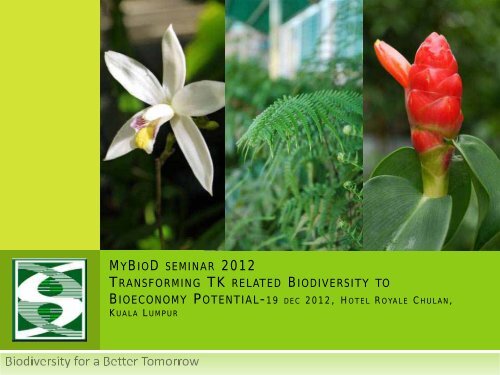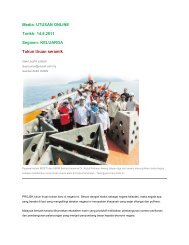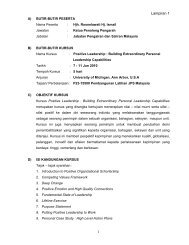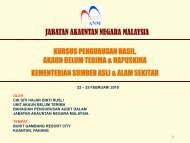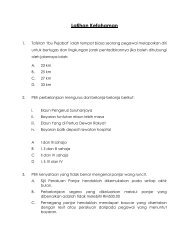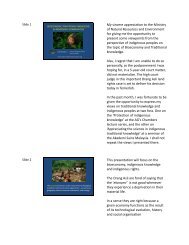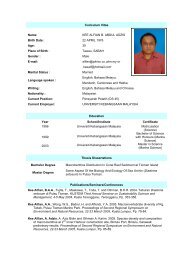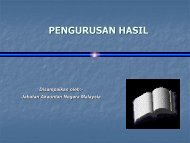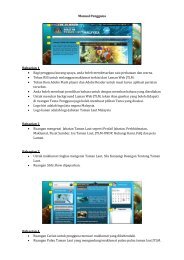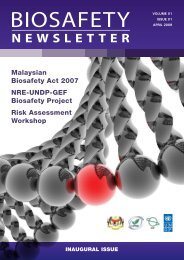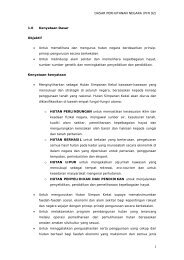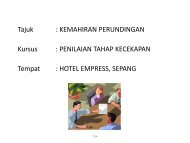Sarawak Biodiversity Centre - NRE
Sarawak Biodiversity Centre - NRE
Sarawak Biodiversity Centre - NRE
You also want an ePaper? Increase the reach of your titles
YUMPU automatically turns print PDFs into web optimized ePapers that Google loves.
MYB IOD SEMINAR 2012<br />
T RANSFORMING TK RELATED BIODIVERSITY TO<br />
B IOECONOMY POTENTIAL- 19 DEC 2012, HOTEL ROYALE CHULAN,<br />
K UALA LUMPUR
OUTLINE OF THE TALK<br />
<br />
<br />
<br />
<br />
<br />
Introduction to SBC<br />
Traditional knowledge and natural products library<br />
A few progressive projects with potential impact on<br />
bioeconomy<br />
A TK documentation effort in combination with<br />
science and biodiversity to promote ecotourism in<br />
an indigenous community-Long Iman, Mulu<br />
Remarks
SBC’S VISION AND MISSION<br />
VISION<br />
<br />
To be the centre of excellence for biodiversity<br />
research and sustainable utilisation<br />
MISSION<br />
<br />
To discover and harness <strong>Sarawak</strong>’s biodiversity<br />
resources through research and development for<br />
the benefit of <strong>Sarawak</strong> & mankind
CORE ACTIVITIES AT SBC<br />
<br />
<br />
Facilitate Traditional Knowledge Documentation<br />
among <strong>Sarawak</strong>’s indigenous communities<br />
Part of life and heritage<br />
Many ethnic groups and TK is slowly lost<br />
Information is important as leads for discoveries<br />
Passing on to the next generation<br />
R&D/Bioprospecting Programmes<br />
Discover new applications<br />
Develop applications for commercial purposes<br />
Sustainable
DOCUMENT TRADITIONAL KNOWLEDGE ON THE USE OF THE<br />
BIODIVERSITY FOR AN APPLICATION
O VER THE YEARS MANY ETHNO- PLANTS HAVE BEEN DOCUMENTED<br />
- POTENTIAL FOR DEVELOPMENT OF PHARMACEUTICALS, HERBAL<br />
PRODUCTS, PERSONAL CARE ETC.<br />
Use<br />
No of Plants<br />
collected<br />
Use<br />
No of Plants<br />
collected<br />
Medicine 1149 Fish poison 29<br />
Food 482 Dye 28<br />
Ritual 78 Repellent 28<br />
Building Material 76 Food for animal 20<br />
Craft 69 Wrapper 20<br />
Shampoo 62 Health care 16<br />
Poison 54 Source of vitamin 11<br />
Antidote 46 Animal stimulant 10<br />
Drink 42 Fire wood 10<br />
Fragrance 41 Cigarette 8<br />
Flavour 38 Cloth 1
Extracts are Routed for Rapid Screening Collaboration
Pharmaceutical<br />
Herbals<br />
ON-GOING TK RELATED<br />
BIODIVERSITY PROJECTS<br />
Bio-economic impact<br />
High<br />
<br />
<br />
<br />
Functional ingredients<br />
<strong>Biodiversity</strong> makes scents! Essential oils and<br />
capturing scents<br />
Opportunities of linking TK related biodiversity to<br />
ecotourism –experience at Long Iman<br />
Middle<br />
Sustainable
Silvestrol-an interesting anticancer compound from Borneo<br />
• In 2004, Dr. Douglas Kinghorn (Ohio State<br />
University) together with collaborators<br />
described silvestrol, a compound isolated<br />
from a plant collected in Central<br />
Kalimantan.<br />
Aglaia sp.<br />
Aglaia silvestris (corr. A. foveolata)<br />
Local name: Langsat Kelawit.<br />
• Forest Department <strong>Sarawak</strong><br />
collaborated with Australian company<br />
and compound CBL316 was patented<br />
from Aglaia leptantha.
Dioxanyloxy group<br />
O<br />
OCH 3<br />
Cyclopenta[b]benzofuran backbone<br />
OCH 3<br />
HO<br />
O<br />
O<br />
HO HO<br />
H<br />
OH COOCH 3<br />
O<br />
Silvestrol<br />
OCH 3<br />
M.W. 654.23
SILVESTROL: RESEARCH IN PROGRESS AT PRE-<br />
CLINICALS TOWARDS HUMAN CLINICAL TRIALS<br />
In vitro<br />
<br />
<br />
Various types of cancer cell<br />
line<br />
Unique mechanism of action<br />
in cancers<br />
Evaluation<br />
Animal cancer models<br />
In vitro human leukemia<br />
blood cells<br />
<br />
<br />
Cell type selectivity<br />
Overcome drug resistance in<br />
cancers<br />
Issues<br />
Supply<br />
Difficult to synthesize<br />
Toxicity<br />
Efficacy in humans<br />
others
UNDERLYING IMPORTANCE-<br />
IP PROTECTION TO CLAIM OWNERSHIP<br />
SILVESTROL’S PATENT IS WORLD WIDE<br />
<br />
<br />
PATENT TITLE : “Therapeutic<br />
compounds and methods”<br />
PATENT NO.US 6,710,075 B2<br />
ASSIGNEE<br />
<br />
The Government of the State of<br />
<strong>Sarawak</strong>, Malaysia<br />
FILING DATE :Nov. 8, 2002<br />
COUNTRIES/ REGION COVERED BY PATENT<br />
<br />
<br />
USA, Canada, Japan, Australia<br />
European Union (11 countries)<br />
LICENSE TO OHIO STATE UNIVERSITY<br />
June 2012<br />
<br />
To develop as a therapy for cancers
FUNCTIONAL INGREDIENTS AND<br />
BIODIVERSITY<br />
<br />
<br />
Definition: Ingredients that<br />
provide some health benefits<br />
above and beyond basic<br />
nutrition; sweeteners, antioxidant,<br />
vitamins<br />
Can be sourced from plants<br />
Sweeteners<br />
Sugar<br />
Salt
COLLABORATION TO SEARCH FOR NEW<br />
SWEETENERS, SALT/MSG REPLACEMENT, FLAVOURS<br />
AND TASTE MODIFIERS
EXAMPLES OF TK PLANTS FOR FLAVOUR/TASTE MODIFIERS<br />
Lemba Kumang (Curculigo<br />
latifolia)<br />
Community Claims:<br />
Fruits are eaten and also as an<br />
antidote to prevent drunkenness<br />
R & D Findings:<br />
Contain curculin (taste<br />
modifying activities )<br />
Potential Products:<br />
Natural sweetener<br />
Lemuntin (Melastoma sp.)<br />
Community Claims:<br />
Young shoots are cooked<br />
with bitter vegetable to ‘kill’<br />
bitter taste<br />
Fruits are eaten and gives<br />
bluish black colouring<br />
Daun Tubu (Pycnarrhena<br />
borneensis)<br />
Community Claims:<br />
Leaves are mixed with<br />
vegetable or tapioca leaves<br />
when cooking to replace MSG
<strong>Biodiversity</strong> makes Scents”<br />
Essential oils<br />
Fragrances<br />
Flavours<br />
Spices
PROJECT: TO DEVELOP AND COMMERCIALIZE<br />
MEDICINAL & AROMATIC OILS FROM SARAWAK’S<br />
BIODIVERSITY<br />
Aim of the project<br />
<br />
<br />
Inventory of <strong>Sarawak</strong>’s indigenous plant species that<br />
produce medicinal and aromatic oils<br />
Create a repository of these oils with their usage and<br />
chemical information for research and collaboration<br />
Commercialize products from the oils and creating a value<br />
chain back to the community<br />
<br />
156 types of essential oils and analyze their chemical<br />
compositions
A TK PLANT WITH COMMERCIAL<br />
POTENTIAL<br />
TENEM / PAHKAK (Litsea cubeba)<br />
Habitat:<br />
• Grows wild in the highland areas – Penrissen,<br />
Bario, Long Semadoh & Ba’Kelalan Highlands<br />
• Used by Bidayuh, Kelabit & Lun Bawang<br />
communities<br />
Community Claims:<br />
•Fruits are used as a cooking condiment and to<br />
relieve stomachache<br />
•Leaves are placed on mattresses for people to lie<br />
on to relieve backaches<br />
R & D Findings:<br />
•Essential oil with good anti-microbial properties<br />
Traditional and scientific claims!
Fruits<br />
Citronellal<br />
D-limonene<br />
Diversity of<br />
Chemicals in Essential Oil of Pahkak<br />
Leaves<br />
Eucalyptol<br />
Phellandrene<br />
Terpineol<br />
Bark<br />
Citronellal<br />
Eucalyptol<br />
Isopulegol<br />
Stem<br />
Eucalyptol<br />
Citronellal<br />
D-limonene<br />
Terpineol
VARIETY OF TOOTHPICKS IN THE MARKET INFUSED WITH<br />
ESSENTIAL OILS GAVE US AN IDEA FOR PAHKAK!<br />
Menthol, Cinnamon oil,<br />
Tea Tree Oil, Peppermint Oil,<br />
Spearmint Oil, Oil of<br />
Seed Fennel<br />
Made in<br />
USA<br />
USD2.75<br />
Mint Oil, Tea Tree Oil,<br />
Cinnamon Oil<br />
Made in<br />
USA<br />
USD1.99<br />
RM8.45/ box of 100 sticks<br />
= RM0.085/pc<br />
RM6.00/ box of 35 sticks<br />
= RM0.171/pc<br />
Made in<br />
Sweden<br />
SEK25<br />
Made in<br />
Australia<br />
USD3.28<br />
0.13 mg Sodium Fluoride<br />
Per toothpick<br />
PEG-6, Tea Tree Oil,<br />
Cinnamon Oil, Menthol<br />
RM11.65/ box of 125 sticks<br />
= RM0.093/pc<br />
RM9.80/ box of 100 sticks<br />
= RM0.098/pc
Finding an Application for Pahkak<br />
Antibacterial Properties<br />
20 mm<br />
8 mm<br />
Porphyromonas gingivales<br />
Porphyromonas gingivales<br />
Streptococcus mutans<br />
Streptococcus mutans<br />
Negative Control: Without<br />
Pahkak Oil<br />
With Pahkak Oil<br />
Negative Control: Without<br />
Pahkak Oil<br />
With Pahkak Oil
Bench Marking Inhibitory Activity of Products<br />
Against Oral Pathogens<br />
No.<br />
Sample<br />
Inhibition Zone on<br />
Periodontal Pathogens<br />
SM<br />
PG<br />
1 Litsara TM + ++++<br />
2 Tea Tree Therapy TM ++ +++<br />
SM = Streptococcus mutans (tooth decay)<br />
PG = Porphyromonas gingivales (gingivitis and bad breath)<br />
+ = 3 – 18 mm diameter of inhibition zone<br />
++ = 19 – 37 mm diameter of inhibition zone<br />
++++ = 38 – 56 mm diameter of inhibition zone<br />
+++++ = 75 – 90 mm diameter of inhibition zone
Intellectual Properties are filed to<br />
Protect Interests<br />
• Patented oral care product (Litsara TM Toothpick).<br />
• Geographical Indicator (<strong>Sarawak</strong> Litsea).<br />
• Trademark (Litsara TM ).
Future Development of Additional Applications of<br />
Pahkak Essential Oil<br />
Pahkak<br />
Essential Oil<br />
Toiletries<br />
Repellents<br />
Disinfectants<br />
Soaps<br />
Shampoo<br />
Mosquito<br />
Sand fly<br />
Hand wipes<br />
Sanitizers
WHY START WITH TOOTHPICKS…..<br />
A N I DEA TO CREATE A VALUE C HAIN FOR A C OTTAGE<br />
I NDUSTRY AND PROMOTE COMMUNITY’S PARTICIPATION<br />
Contract Farming<br />
Potential Benefits:<br />
•Sale of raw material<br />
•Sale of essential oil<br />
•Royalty<br />
•IPRs<br />
•Sales of Products<br />
Sustainable Collection<br />
Steam Distillation<br />
Healthcare Product<br />
Development
PROGRESS OF PAHKAK WORK SO<br />
FAR….<br />
Inventory the plant distribution in <strong>Sarawak</strong><br />
R & D<br />
Developed some prototype products<br />
Propagation research<br />
Material Safety Data Sheet<br />
Trademark registration<br />
Geographical Indication registration<br />
New Use Patent application<br />
Next step is to look for an international market
Next Project: How to Capture a Scent from a flower...<br />
Trapping floral volatiles of Hedychium. Coronarium<br />
Kaiser R. et al
IDENTIFICATION OF CHEMICAL IN A SCENT<br />
FROM GC-MS<br />
No<br />
Hedychium coronarium flowers<br />
Compounds RT (min) Quality<br />
(%)<br />
Area (%)<br />
1 Butyl aldoxime, 2-methyl-, syn- 3.804 81 13.96<br />
2 Butyl aldoxime, 3-methyl-, syn- 4.040 87 5.2<br />
3 Eucalyptol 7.524 98 12.75<br />
4 Benzoic acid, methyl ester 9.672 91 13.36<br />
5 1,6-Octadien-3-ol, 3,7-dimethyl- 9.919 97 45.5<br />
6 Indole 17.925 94 5.15<br />
7 Benzoic acid, 2-amino-, methyl<br />
ester<br />
19.713 94 4.08<br />
Scents reconstruction: Givaudan Corporation, Switzerland<br />
The goal is to produce a line of fragrances from <strong>Sarawak</strong>’s <strong>Biodiversity</strong>
“LONG IMAN, MULU:<br />
TK RELATED BIODIVERSITY,<br />
SCIENCE, NATURE TRAIL AND<br />
INDIGENOUS COMMUNITY GARDEN”-<br />
PACKAGE FOR ECOTOURISM
ABOUT LONG IMAN, MULU<br />
<br />
<br />
<br />
Long Iman is located along the bank of Tutoh river, a 30 mins<br />
boat ride from Gunung Mulu National Park (GMNP), a World<br />
Heritage site.<br />
The Penan community at Long Iman is one of the first<br />
indigenous groups that has successfully documented their<br />
knowledge on plant uses with <strong>Sarawak</strong> <strong>Biodiversity</strong> <strong>Centre</strong><br />
(SBC). Project started since 2002.<br />
The Penans traditionally led a nomadic livelihood in the<br />
forests. Knowledge of the forests is bountiful.
WHAT DO THEY HAVE <br />
Interpretative Building & A Community Garden<br />
Knowledge of useful plants<br />
Tourists from Mulu<br />
Community that has<br />
interests in preserving their<br />
traditional knowledge<br />
A scenic waterfall and boat ride to the<br />
village<br />
Handicrafts
WHAT CAN BE DONE…<br />
<br />
<br />
<br />
To create an eco nature trail at Long Iman connecting the<br />
village to a scenic waterfall<br />
To improve and expand the existing Long Iman Community<br />
Garden of useful plants incorporating scientific information<br />
To highlight Long Iman as a venue of rich culture and<br />
knowledge of biodiversity to eco-tourists<br />
Combination of TK, biodiversity, ecotourism and science to bring<br />
income that are sustainable to the community
Participants and speakers at the Traditional Knowledge Documentation Workshop 2012<br />
19-22 Nov 2012
CLOSING REMARKS<br />
<br />
<br />
<br />
<br />
<br />
Traditional knowledge related biodiversity provide many<br />
opportunities and ideas to develop bio-based economy<br />
The bioeconomy should bring benefits to the communities to<br />
sustain their livelihood and conserve biodiversity as well<br />
IP protection is important to ensure that rights are retained<br />
There are long- and short-term project plans, from<br />
pharmaceuticals to personal care products, so that the end- point<br />
can be achieved within a reasonable time<br />
Ecotourism can contribute to the bioeconomy because TK,<br />
biodiversity and science can be combined to make a good story<br />
and a fulfilling experience for tourists
THANK YOU<br />
QUESTIONS<br />
CONTACT US AT<br />
<strong>Sarawak</strong> <strong>Biodiversity</strong> <strong>Centre</strong><br />
KM20, Jalan Borneo Heights, Semengoh<br />
93250, Kuching, <strong>Sarawak</strong><br />
Tel: +6 082 610610 Fax: +6 082 611535<br />
Email: biosar@sbc.org.my<br />
URL: www.sbc.org.my


